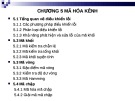
1
Summary and Introduction
Broadband wireless communications have gained an increased interest during the last few
years. This has been fuelled by a large demand on high frequency utilisation as well as a large
number of users requiring simultaneous high data rate access for the applications of wireless
mobile Internet and e-commerce. The convergence of wireless mobile and access will be the
next storm in the wireless communications, which will use a new network architecture to
deliver broadband services in a more generic configuration to wireless customers and
supports value-added services and emerging interactive multimedia communications.
Large bandwidth, guaranteed quality of service and ease of deployment coupled with recent
great advancements in semiconductor technologies make this converged wireless system a
very attractive solution for broadband service delivery.
1.1 Introduction
‘The future of wireless is not just wireless, it is a part of life’. When we trace back to the
1980s, everyone dreamed to have a nice mobile phone. But if we dream of the wireless
picture in 2010, the story will be totally different. Why? Because by that time, the wireless
infrastructure (not just for communications) will be totally multi-dimensional, whether in
technologies (diversified and harmonised), applications (free mobile, local or global), or
services (service/bandwidth on demand). Our wireless personal communicator or assistant
(the size of a wallet or up to a book with enough bandwidth and memory) can help us enjoy
our lives. Wireless becomes easy and affordable in the mass market, even when you are away
from your office; your business will never be off-line. The global roaming and high-speed
wireless link (thanks to the tremendous silicon advancements) will make our travels wonder-
ful and feel at home.
The key applications evolved from the advancement of broadband wireless, and the under-
lining technologies, including broadband wireless mobile (3Gwireless and 4Gmobile), broad-
band wireless access, broadband wireless networking, as well as broadband satellite solutions
will surely dominate the whole communications market and therefore improve the business
model in many aspects.
Convergence of broadband wireless mobile and access will be the next storm in wireless
communications. Fuelled by many emerging technologies including digital signal processing,
software definable radio, intelligent antennas, superconductor devices as well as digital
transceiver, the future wireless system will be much more compact with limited hardware
entity and more flexible and intelligent software elements. Re-configurable and adaptive
Broadband Wireless Mobile: 3G and Beyond. Edited by Willie W. Lu
Copyright 2002 John Wiley & Sons, Ltd.
ISBN: 0-471-48661-2

terminals and base stations helps the system easily applied in the wireless mobile as well as
wireless access applications. The compact hardware and very small portion of software
(called Common Air Interface Basic Input-Output System or CAI-BIOS) will go the way
as the computer industries did in the past. A compact multi-dimensional broadband wireless
model will be adopted for the system design and implementation.
Wireless Mobile Internet will be the key application of this converged broadband wireless
system. The terminal will be very smart instead of dumb, compatible to mobile and access
services including wireless multicasting as well as wireless trunking. This new wireless
terminal will contain the following features:
†90% of traffic will be data;
†security function will be enhanced, e.g. finger print chip embedded;
†voice recognition function will be enhanced, the keypad or keyboard attachment will be an
option, and wireless;
†the terminal will support single and multiple users with various service options;
†the terminal will be a fully adaptive software reconfigurable terminal.
As the wireless communications evolve to this convergence, the 4Gmobile (Fourth
Generation Mobile Wireless Communications) will be an ideal mode to support high data-
rate connections from 2Mbps to 20Mbps based on the new spectrum requirement for IMT-
2000 as well as the co-existence of the current spectrum for broadband wireless access. This
4Gmobile system’s vision aims at:
†providing a technological response to an accelerated growth in the demand for broadband
wireless connectivity;
†ensuring seamless services provisioning across a multitude of wireless systems and
networks, from private to public, from indoor to wide area;
†providing the optimum delivery of the user’s wanted service via the most appropriate
network available;
†coping with the expected growth in the Internet-based communications;
†opening new spectrum frontiers.
Figure 1.1 shows the convergence of wireless mobile and access in one track and generates
the 4Gmobile. In the following sections, we will discuss some detailed implementation issues
including system architecture, reference model, protocol stack as well as system design.
Broadband Wireless Mobile: 3G and Beyond2
Figure 1.1 Convergence of wireless mobile and access in one track.

1.2 Network Architecture
The future wireless network should be an open platform supporting multi-carrier, multi-band-
width and multi-standard air interfaces, and content-oriented bandwidth-on-demand (BoD)
services will dominate throughout the whole network. In this way, the packetised transmission
will go all the way from one wireless end terminal to another directly. Figure 1.2 shows this new
wireless network architecture. The major benefits of this architecture are that the network
design is simplified and the system cost is greatly reduced. The Base Transceiver System
(BTS) is now a smart open platform with a basic broadband hardware pipe embedded with a
CAI BIOS. Most functional modules of the system are software definable and re-configurable.
The packet switching is distributed in the broadband packet backbone (or core network called
Packet Division Multiplex –PDM). The wireless call processing, as well as other console
processing, is handled in this network. The Gateway (GW) acts as proxy for the Core Network
and deals with any issues for the BTS, and the BTS is an open platform supporting various
standards and optimised for full harmonisation and convergence. The terminal (Mobile Station
–MS) can be single or multi-users oriented supporting converged wireless applications. Figure
1.3 illustrates the unified wireless networks based on this architecture [1].
Summary and Introduction 3
Figure 1.2 Network reference model.

1.3 Protocol Stack
Considering the signalling protocol in Figure 1.2, the client-server model is established
between a wireless terminal and the core network. The BTS becomes the agent in both
directions. This end-to-end direct signalling can ensure the wireless terminal to be smart
and intelligent rather than the dumb one in the current wireless system. Figure 1.4(a) shows
the system protocol stack.
Different services (ATM, IP, STM, MPEG, etc.) can be supported through ‘Service
Convergence Layer’. To guarantee the Wireless QoS (quality of service) and high spectrum
utilisation, a Dynamic Bandwidth Allocation (DBA) scheme is required through the ‘MAC
DBA Sublayer’which improves the conventional layer architecture. DBA scheduler is the
core of the MAC. To realise the dynamic resource allocation, this scheduler is essential for
the broadband wireless link, which in general helps:
†support class of service offerings;
†provide diagnostic support for all network protocols;
†eliminate the need for traffic shaping and user parameter control;
†eliminate end-to-end packet and/or cell delay variation;
†increase spectrum utilisation.
The ‘Transmission Convergence Layer’handles with various transmission modulations,
error corrections, segmentations as well as interface mappings of wireless mobile and access
in the physical layer. Figure 1.4(b) shows an example for the support of wireless access
applications.
Broadband Wireless Mobile: 3G and Beyond4
Figure 1.3 Unified wireless networks.

1.4 Compact Open Core
As mentioned in the previous sections, this converged broadband wireless system will have
the following features:
†multi-standards: 3Gwireless plus broadband wireless access
†high channel density with efficient resource utilisation
†dynamically scalable data-rates: from 32 kbps to 20 Mbps
†software definable and over-the-air programmable modules
†open core: various re-configurable kernels and common air interface BIOS
Figure 1.5 depicts this multi-dimensional and re-configurable radio [1], while Figure 1.6
shows its open interfaces. As wireless goes multi-dimensional, different standards come out
everyday for different applications. However, if you look at their architectures in details, most
of them are the same or almost the same. The ‘All IP’layer will become the common
platform; the service will be based on the secured Wireless Mobile Internet; the convergence
will focus on the variable services demand as well as transmission technologies.
From the implementation point of the view, in the future, the wireless software will take
about 75% of the work, while the hardware only takes 25% for the construction of the open
platform. Figure 1.7 shows this basic hardware structure.
The ‘digital block’will eventually be implemented in one system (system-on-chip). The
‘analogue block’outputs as an open module subject to various CAI standards. With the
Summary and Introduction 5
Figure 1.4 (a) General protocol stack. (b) Protocol stack: example.














![Bộ tài liệu Đào tạo nhân viên chăm sóc khách hàng tại đơn vị phân phối và bán lẻ điện [Chuẩn nhất]](https://cdn.tailieu.vn/images/document/thumbnail/2025/20251001/kimphuong1001/135x160/3921759294552.jpg)


![Ngân hàng câu hỏi thi giữa kì môn Truyền động điện [Mới nhất]](https://cdn.tailieu.vn/images/document/thumbnail/2025/20250920/kimphuong1001/135x160/42601758354546.jpg)


![Câu hỏi ôn tập Quy trình an toàn điện có đáp án [kèm đáp án chi tiết]](https://cdn.tailieu.vn/images/document/thumbnail/2025/20250920/kimphuong1001/135x160/18761758354548.jpg)
![Đề thi trắc nghiệm Kỹ thuật mạch điện tử: Tổng hợp [Năm]](https://cdn.tailieu.vn/images/document/thumbnail/2025/20250920/kimphuong1001/135x160/23481758356189.jpg)


![Tài liệu ôn tập Thông tin quang [năm] [mới nhất]](https://cdn.tailieu.vn/images/document/thumbnail/2025/20250917/anvunguyen0207@gmail.com/135x160/56551758168054.jpg)

